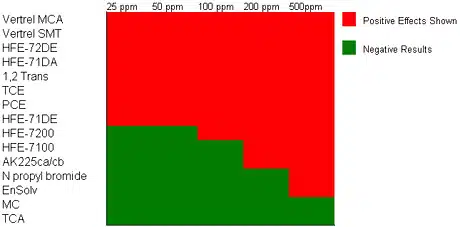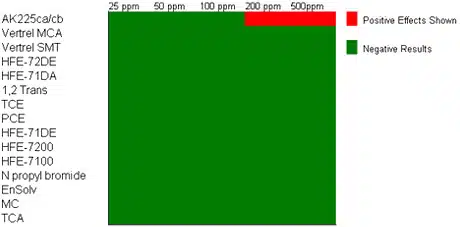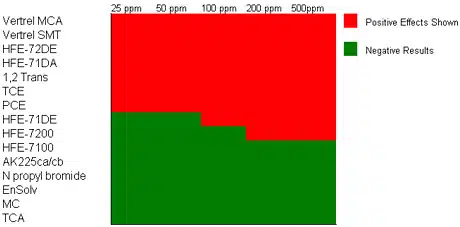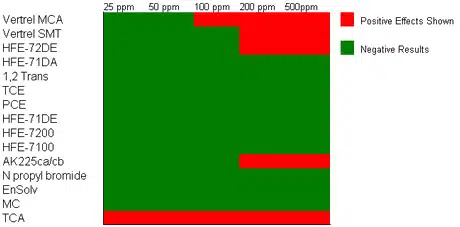CONTENT ON THIS PAGE IS RETAINED FOR INFORMATION ONLY
DUE TO n-Propyl bromide now being included in Annex 14 of REACH
EnviroTech Europe Ltd (ETE) continue to publish it as historical information and to record changes occurring in legislation which have affected decisions on formulations and equipment used in vapour degreasing - the most effective, quickest, flexible and cheapest cleaning system used in industry.
EnSolv® invented and patented by EnviroTech has been a market leader all over the world for vapour degreasing. It is based on n-bromopropane (nPB) which now cannot be used as a vapour degreaser within the UK or EU without authorisation.
Archived information about EnSolv® can be found using the Discontinued Products & Resources navigation menu on this page.
Using experience accumulated over 40 years supplying and supporting users of the vapour degreasing process ETE specialists have developed “drop in” alternatives:
ProSolv®, ProSolv5408e® and EnSolv CC-A® give the same or improved level of performance and economy as the original EnSolv® products.
Please contact our advisers who are available to discuss your needs and propose the best replacement product.
Or please click here to return to our vapour degreasing products homepage for information about our current products.
Human Cell Bioassay comparison of Vapour degreasing solvents
SENSATIONAL RESULTS FROM NEW STUDY COMPARING COMMONLY USED VAPOUR DEGREASING SOLVENTS
EnSolv® shown to be safest of all the commercially available alternatives
EnviroTech International Inc, manufacturers of EnSolv® precision cleaning solvent a patented, stabilised n-Propyl Bromide (nPB) based vapour degreasing solvent have extended the unique series of in vitro human bioassay tests, originally published in 2001, which compared nPB, and the formulated EnSolv® solvent, with commonly used chlorinated solvents, to include other recently introduced halogenated vapour degreasing solvents based on fluorine chemistry. These tests are part of the ongoing product stewardship programme for EnSolv® sponsored by EnviroTech International Inc.
Safety standards for cleaning solvents is complex and raises many contentious issues. Vapour degreasing is very widely used as the process of choice for industries where critical cleaning is required. Many new solvents have been introduced which have been designed to address factors such as VOC (volatile organic content), flammability, cleaning efficiency and most importantly operator safety. Choosing the right solvent is becoming more difficult with the increased choices available.
In a new report, now undergoing scientific peer review, to be published later this year, the authors detail the results of the in vitro human cell bioassay studies using techniques developed by Enviromed Laboratories with Dr. Khosrow Adeli of the University of Toronto Hospital for Sick Children which assess the results and produce a comparative rating for the solvents according to their toxicity for human cells.
Comparative study of commonly used vapour degreasing solvents
EnviroTech International Inc, manufacturers of EnSolv® precision cleaning solvent a patented, stabilised n-Propyl Bromide (nPB) based vapour degreasing solvent have extended the unique series of in vitro human bioassay tests, originally published in 2001, which compared nPB, and the formulated EnSolv® solvent, with commonly used chlorinated solvents, to include other halogenated vapour degreasing solvents based on fluorine chemistry. These tests are part of the ongoing product stewardship programme for EnSolv® sponsored by EnviroTech International Inc.
Safety standards for cleaning solvents is complex and raises many contentious issues. Vapour degreasing is very widely used as the process of choice for industries where critical cleaning is required. Many new solvents have been introduced which have been designed to address factors such as VOC (volatile organic content), flammability, cleaning efficiency and most importantly operator safety. Choosing the right solvent is becoming more difficult with the increased choices available.
In a new report, now undergoing scientific peer review, to be published later this year, the authors detail the results of the in viro human cell bioassay studies using techniques developed by Enviromed Laboratories with Dr. Khosrow Adeli of the University of Toronto Hospital for Sick Children which assess the results and produce a comparative rating for the solvents according to their toxicity for human cells.
Introduction
Increasing public interest in these issues has created a demand for alternatives to using animals in toxicology testing. Both the US EPA and the European Union have stated that the use of animals for testing must be reduced to minimal levels and be replaced by other toxicological screening methods to assess human health risk associated with exposure to environmental toxicants. Such screening tools should allow for risk evaluation in terms of both short-term/acute toxicity as well as longer-term genetic damage that may lead to mutagenicity and carcinogenicity. This battery of human cell bioassays using the human hepatoma cell-line, HepG2, assess both cytotoxic and genotoxic potential of environmental pollutants.
HepG2 cells were exposed to various vapour degreasing solvents in common use worldwide at concentrations ranging from 25 to 500 ppm. The cells were then analyzed using specific protocols for four different adverse effects: cell death/acute cytotoxicity altered enzyme function – often an indicator of cell stress, DNA single strand breaks as well as DNA repair induction which evaluates mutagenic activity. The high sensitivity of the tests allowed for environmentally meaningful assessments and precision studies showed excellent reproducibility for all four bioassays. Comparing the results of the four bioassays on each of vapour degreasing solvents allowed for ranking of the anticipated relative human toxicity of these solvents, which were comparable with data from standard toxicity tests and human occupational data. Overall, the study clearly supports the application of the HepG2 cell bioassay system for rapid toxicological screening of many candidate toxicants in both short-term as well as long-term toxicity potential.
Solvents tested
The hologenated cleaning solvents screened for toxicity were:
n-propyl bromide also known as 1-bromopropane (nPB),
EnSolv® ( patented stabilized nPB),
1,1,1-trichloroethane (TCA),
trichloroethylene also known as trike (TCE),
perchloroethylene also known as tetrachloroethylene (PCE),
methylene chloride also known as dichloromethane (MC)
isopropyl bromide also known as 2-bromopropane (iPB),
AK225ca/cb (a mixture of 3,3-dichloro-1,1,1,2,2-pentafluoropropane and 1,3-dichloro-1,1,1,2,2-pentafluoropropane),
DPF, 3,3-dichloro-1,1,1,2,2-pentafluoropropane/1,3-dichloro-1,1,1,2,2-pentafluoropropane (DPF),
HFE-72DE (a mixture of methyl nonafluorobutyl ether [C4F9OCH3], ethyl nonafluorobutyl ether [C4F9OC2H5], and trans-1,2-dichloroethylene [TDE]) ,
HFE-7100 ( methoxy-nonafluorobutane),
HFE-7200 ( ethoxy-nonafluorobutane) ,
HFE-71DE (methylnonafluorobutyl ether in an azeotrope formulation with TDE) ,
HFE-71DA (methylnonafluorobutyl ether in an azeotrope formulation with TDE and ethanol) ,
VERTEL SMT (1,1,1,2,3,4,4,5,5,5-decafluoropentane, TDE and stabilizer),
VERTEL MCA (1,1,1,2,3,4,4,5,5,5-decafluoropentane),
TDE (trans 1,2 – dichloroethylene)
| Cytotoxicity | EROD | DNA Strand Break | DNA Repair Activity | |
|---|---|---|---|---|
| Adverse Effect Shown at 25 ppm | ||||
| Vertrel MCA | Positive (all doses 25 ppm and higher) | No Effect | Positive (all doses 25 ppm and higher) | Positive (all doses 100 ppm and higher) |
| Vertrel SMT | Positive (all doses 25 ppm and higher) | No Effect | Positive (all doses 25 ppm and higher) | Positive (all doses 200 ppm and higher) |
| HFE-72DE | Positive (all doses 25 ppm and higher) | No Effect | Positive (all doses 25 ppm and higher) | Positive (all doses 200 ppm and higher) |
| HFE-71DA | Positive (all doses 25 ppm and higher) | No Effect | Positive (all doses 25 ppm and higher) | No Effect |
| 1,2 Trans | Positive (all doses 25 ppm and higher) | No Effect | Positive (all doses 25 ppm and higher) | No Effect |
| TCE | Positive (all doses 25 ppm and higher) | No Effect | Positive (all doses 25 ppm and higher) | No Effect |
| PCE | Positive (all doses 25 ppm and higher) | No Effect | Positive (all doses 25 ppm and higher) | No Effect |
| TCA | No Effect | No Effect | No Effect | Positive (all doses 25 ppm and higher) |
| HFE-71DE | Positive (all doses 25 ppm and higher) | No Effect | Positive (all doses 100 ppm and higher) | No Effect |
| First Effects at 100 ppm | ||||
| HFE-7200 | Positive (all doses 100 ppm and higher) | No Effect | Positive (all doses 200 ppm and higher) | No Effect |
| First Effects at 200 ppm | ||||
| HFE-7100 | Positive (all doses 200 ppm and higher) | No Effect | No Effect | No Effect |
| AK225ca/cb | Positive (all doses 200 ppm and higher) | Positive (all doses 200 ppm and higher) | No Effect | Positive (all doses 200 ppm and higher) |
| First Effects at 500 ppm | ||||
| N propyl bromide | Positive (500 ppm, highest dose tested) | No Effect | No Effect | No Effect |
| EnSolv | Positive (500 ppm, highest dose tested) | No Effect | No Effect | No Effect |
| No Effects | ||||
| MC | No Effect | No Effect | No Effect | No Effect |
| Cytotoxicity | EROD | DNA Strand Break | DNA Repair Activity | |
|---|---|---|---|---|
| Adverse Effect Shown at 25 ppm | ||||
| Vertrel MCA | Positive (all doses 25 ppm and higher) | No Effect | Positive (all doses 25 ppm and higher) | Positive (all doses 100 ppm and higher) |
| Vertrel SMT | Positive (all doses 25 ppm and higher) | No Effect | Positive (all doses 25 ppm and higher) | Positive (all doses 200 ppm and higher) |
| HFE-72DE | Positive (all doses 25 ppm and higher) | No Effect | Positive (all doses 25 ppm and higher) | Positive (all doses 200 ppm and higher) |
| HFE-71DA | Positive (all doses 25 ppm and higher) | No Effect | Positive (all doses 25 ppm and higher) | No Effect |
| 1,2 Trans | Positive (all doses 25 ppm and higher) | No Effect | Positive (all doses 25 ppm and higher) | No Effect |
| TCE | Positive (all doses 25 ppm and higher) | No Effect | Positive (all doses 25 ppm and higher) | No Effect |
| PCE | Positive (all doses 25 ppm and higher) | No Effect | Positive (all doses 25 ppm and higher) | No Effect |
| TCA | No Effect | No Effect | No Effect | Positive (all doses 25 ppm and higher) |
| HFE-71DE | Positive (all doses 25 ppm and higher) | No Effect | Positive (all doses 100 ppm and higher) | No Effect |
| First Effects at 100 ppm | ||||
| HFE-7200 | Positive (all doses 100 ppm and higher) | No Effect | Positive (all doses 200 ppm and higher) | No Effect |
| First Effects at 200 ppm | ||||
| HFE-7100 | Positive (all doses 200 ppm and higher) | No Effect | No Effect | No Effect |
| AK225ca/cb | Positive (all doses 200 ppm and higher) | Positive (all doses 200 ppm and higher) | No Effect | Positive (all doses 200 ppm and higher) |
| First Effects at 500 ppm | ||||
| N propyl bromide | Positive (500 ppm, highest dose tested) | No Effect | No Effect | No Effect |
| EnSolv | Positive (500 ppm, highest dose tested) | No Effect | No Effect | No Effect |
| No Effects | ||||
| MC | No Effect | No Effect | No Effect | No Effect |
Each solvent was tested at various doses of 25-500 PPM using each of four cell bioassays in HepG2 cells to assess:
Cytotoxicity
(cell death) based on the ability of normal healthy cells to take up nutrients.A toxic response lowers the rate of uptake indicating loss of cell viability.
Each solvent was tested at various doses of 25-500 PPM using each of four cell bioassays in HepG2 cells to assess:
Cytotoxicity
(cell death) based on the ability of normal healthy cells to take up nutrients. A toxic response lowers the rate of uptake indicating loss of cell viability.

altered enzyme function activity (often an indicator of cell stress)
altered enzyme function activity (often an indicator of cell stress)


A test was scored as positive when percent change in activity was statistically different from the negative control (p<0.05).

The series of comparative human cell bioassay tests was carried out on all solvents, and the results of these tests were interpreted in terms of relative toxicity. The full report is awaiting peer review and copies will be available later in the year from EnviroTech Europe Ltd.
As shown in the table, all four tests for all compounds tested were run using a range of tissue concentrations from 25 to 500 ppm . The tissue concentrations tested reflect higher actual workplace air concentrations because only a portion of chemicals in inhaled air are actually absorbed, and then only a fraction of the chemical mass actually absorbed reaches target tissues and cells. Therefore, these tissue concentrations provide a good biomarker of potential toxicity of the chemical product in humans exposed to them in the workplace. The sensitivity of these tests was sufficient to identify impacts due to nPB at low concentrations that are environmentally meaningful.
We believe this study marks the first time these solvents have been subjected to an identical set of in vitro cell bioassay tests on human cells. This is one of the important functions of this testing, as it affords a basis for comparing the anticipated relative human toxicity of these solvents. What follows is a critical analysis of relative toxicity based strictly on the outcome of the human bioassay tests.
The comparative relative toxicity across all tested compounds is as follows:
(Most toxic) Vertel MCA > Vertel SMT & HFE72DE > TDE, HFE71DA, TCE & PCE > iPB > HFE71DE > AK225ca/cb > HFE7200 > DPF > HFE7100 > TCA > nPB & EnSolv â > MC (Least toxic).
Both nPB and a stabilized nPB product (EnSolv®) were tested to evaluate the comparative toxicity of the compound and a stabilized formulation. The tests showed that the particular set of compounds comprising the stabilizing formulation for EnSolv® (about 7% of the total mixture ) added to nPB had no effect on overall toxicity.
Other stabilised formulations for n-Propyl Bromide (nPb) exist but were not tested. Since the components of these other stabilised formulations vary widely from those used in the EnSolv® formulation, extrapolation from the results of the EnSolv® stabilised nPB to any product with a different stabilizing formulation is not warranted or advised.
In addition, the human bioassay testing clearly indicates that nPB, although a structural analog of iPB, has neither the mutagenic nor inherent toxicity indicated by the test for iPB. The chlorinated solvents were tested only in their neat form due to the wide variety of stabilizing compounds used with these materials. nPB and EnSolv® stabilized nPB were considered least toxic because the only positive result was at the highest tested dose level. This was not the case for the other solvents.
The solvents containing only a single active ingredient included two chemicals with no toxicity-based standards (nPB and iPB), and other solvents with toxicity-based standards (TCA, TDE, MC, TCE, and PCE). The latter two chemicals are suspected human carcinogens and all have known noncancer toxicity, especially on the liver. Based on USEPA human health-based criteria (e.g., reference doses), the noncancer potency of these four chemicals can be ranked from high to low as follows: TCE > TDE > PCE > TCA > MC.
Results obtained for all solvents tested at seven dose levels ranging from 25 to 500 ppm are summarized in the table . Based on these results, it may be concluded there is no significant toxicity posed by nPB or stabilized nPB at concentrations in the range l00-400 PPM. These results indicate that TCE, TDE, and PCE are similarly toxic of the four tested chlorinated chemicals, and TCA is less toxic, which is consistent with USEPA’s ranking of these chemicals.. This data indicate that the in vitro results obtained from human liver cells are consistent with the relative toxicity of chemicals based on whole animal toxicity testing.
Conclusion
It is important to understand that these tests cannot be easily dismissed because they are not based on animal or human in vivo testing. The results for solvents with a historic and peer reviewed database, such as trichloroethylene are replicated by the Human Cell Bioassay tests and the results for the fluorinated solvents, where there is little independent documentation for comparison, must be an accurate guide to comparative toxicity.
EnSolv® and n-Propyl Bromide are demonstrably safer than all but methylene chloride. As this is not widely used as a vapour degreasing solvent due to its low boiling point these tests indicate that EnSolv® which was tested with nPB is the safest of the practical vapour degreasing solvents.
Conflict of Interest Statement
The bioassays discussed in this article were performed by Enviro Med Laboratories of Windsor , Canada at the request of Enviro Tech International, Inc., which also funded the studies. Enviro Tech International, Inc. is the manufacturer of the EnSolv stabilized nPB-based solvent discussed in the article. Enviro Med Labs and Enviro Tech International, Inc. are unrelated entities with no affiliation of any kind.
EnSolv® is a registered trademark of EnviroTech International Inc.
HFE-72DE, HFE-7100, HFE-71DE and HFE-71DA are trade names and/or trademarks which are the property of 3M Company, St. Pauls , Minnesota .
Vertrel, Vertrel SMT and Vertrel MCA are trade names and/or trademarks which are the property of DuPont Chemicals.
©EnviroTech International Inc. April 2006 The information on this site cannot be downloaded without permission. Please use the contact page if you require printed copies of any sections.

